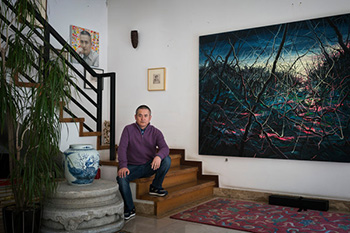
BEIJING — At the gallery opening of China’s hottest-selling artist, Zeng Fanzhi, in Manhattan a year ago, Chinese billionaires mingled with the upper crust of New York’s art world. Mr. Zeng had flown in with his well-to-do pals, and after dinner at a clubby Chelsea restaurant, the Chinese crew retired to the Park Hyatt for late-night drinks in the lobby bar.
北京——一年前在曼哈顿,中国最热卖艺术家曾梵志的画展开幕式上,中国亿万富翁与纽约艺术界精英们共聚一堂。曾梵志和他那些富有的朋友们一道坐飞机赶来,在切尔西一家会所性质的餐厅用餐后,这群中国伙伴深夜又去往柏悦酒店的大堂酒吧喝了一杯。
Here at home, an even larger banquet for 500 guests, including the granddaughter of Mao Zedong, celebrated Mr. Zeng’s 25-year painting career, at the September opening of the first retrospective in his own country.
今年,为庆祝他的绘画生涯25周年,曾梵志在自己的祖国举办了第一次回顾展,9月的开幕式举行了一场更加盛大的宴会,有500位嘉宾出席,其中包括毛泽东的外孙女。
His works hang in American museums and palatial Hong Kong apartments, and over the fireplace in the London living room of the art baron François Pinault, the owner of Christie’s. At the Ullens Center for Contemporary Art in Beijing, record crowds have poured through his current show, which includes two 33-foot-long, fiercely colored landscapes.
他的作品挂在美国的博物馆和富丽堂皇的香港公寓里,还挂在佳士得(Christie’s)拍卖行的主人、艺术巨头弗朗索瓦•皮诺(François Pinault)的伦敦住所的起居室壁炉上。这次展览在北京尤伦斯当代艺术中心(Ullens Center for Contemporary Art)举行,展品包括两幅33英尺(约合10米)长、色彩鲜艳的风景画,蜂拥而至的观众创下了纪录。
Chinese artists roared onto the international art scene about 10 years ago, but few have exhibited the staying power of Mr. Zeng, and none have fetched $23.3 million for a painting at auction, the price paid for his version of “The Last Supper” in 2013.
大约十年前,中国艺术家们大举进军国际艺术界,但很少有人像曾梵志这样长盛不衰,2013年,他创作的《最后的晚餐》在拍卖会上拍出了2330万美元,这个成绩更是无人能及。
How has he managed to stay at the top? “You might say I am very cunning,” he said, a small cheeky smile across his broad, smooth face. “I only sell my paintings to those who really like them. Then those people will help me promote my works.”
他是怎样一直保持在顶峰的?“你肯定会说我很狡猾,”他说,宽阔、光滑的脸上露出略显放肆的微笑。“但我只把我的画卖给欣赏它们的人,然后这些人会帮我推广我的作品。”
It is this approach of cultivating collectors who cherish his art, combined with indisputable painting skills, that has propelled him to the fore, said Philip Tinari, the director of the Ullens Center.
尤伦斯当代艺术中心馆长田霏宇(Philip Tinari)说,结交能赏识他的作品的收藏家,再加上无可争议的绘画技巧,把曾梵志推向了重要地位。
“China needs a great artist, and the way he has gone about it is very intelligent,” Mr. Tinari said. “He understands the milieu his works circulate in, the actual collectors’ homes, cultural institutions and galleries. He invites these key people to be part of his success, and as he achieves higher degrees of validation it’s something everyone feels good about.”
“中国需要一个伟大的艺术家,他处理的方式是非常聪明的,”田霏宇说。“他清楚自己的作品是在什么样的环境里流传的,在真正的收藏家的家中,在文化机构和画廊里。他邀请这些关键人物和他分享自己的成功,一旦他获得更高的认可后,所有人都会感到开心。”
Mr. Zeng, 52, is a compact figure, his cropped hair flecked with a few grays, a Cuban cigar never far from his fingers as he sits in a well-worn red leather chair in his studio. To his usual attire of understated jeans and sneakers, he adds a black gabardine coat for warmth in his chilly space. A retinue of research assistants works at his gray brick complex in an artist enclave not far from the city center.
体格健壮的曾梵志今年52岁,短短的头发上有几处花白,他坐在自己工作室里一张破旧的红色皮革椅子上,一支古巴雪茄不离手。和平时一样,他穿着低调的牛仔裤和运动鞋,因为工作室里有些冷,又添了一件黑色的华达呢外套。这栋灰砖建筑在距离市中心不远的一个艺术家聚居区里,他的研究助理们正忙碌着。
He has come to enjoy the good things in life. An Hermès leather-topped desk sits at one end of his studio, and an eclectic art collection decorates the double storied space that looks onto a manicured garden of graceful trees, two Harry Bertoia steel sculptures and a sprawling goldfish pond.
他已经进入享受生命中美好事物的阶段。工作室的一端是一张皮革台面的爱马仕写字台,庞杂的艺术收藏装点着这个双层空间,向外看去是一个精心打理的花园,有优美的树木,两个哈里•贝尔托亚(Harry Bertoia)的钢铁雕塑和一个大大的金鱼池。
The emerald green lawn appears fresh on a crisp fall day. “It’s not real,” he said sheepishly. Fastidious about things being neat, he grew weary of Beijing’s messy brown grass.
碧绿的草坪在清爽的秋日里显得格外清新。“不是真草,”他难为情地说。他非常讲究整洁,已经厌倦了北京凌乱的棕色草地。
From his early days as a poor art student in Wuhan, a gritty city along the Yangtze River, he caught the attention of teachers and critics who admired his rebellion against the standard fare of Communist-approved social realism.
他来自武汉,那是长江边一个粗粝的城市。还是个艺术学院穷学生的时候,他就引起了教师与评论家的关注,他们纷纷赞美他对共产党认可的社会现实主义美学标准的反叛。
“The head of the library at my school said if I wanted to see better art books, I should go to the library in Zhejiang Province,” he said of the austere days in the mid-1980s. “I took a leave and traveled three days and nights by train to Shanghai, and then another three hours to Hangzhou.” There, and later at the art institute in Wuhan, he discovered the German artist Max Beckmann and admired the work of Willem de Kooning.
“我们学校管图书馆的馆长告诉我说,如果我想要看更好的画册,我应该去浙江,”他回忆80年代中期那些物质匮乏的日子。“然后我就坐了三天三夜的火车到上海,然后又坐了三个小时的车到杭州。”在那里,以及后来在武汉的那所美术学院,他发现了德国艺术家马克斯•贝克曼(Max Beckmann),也开始欣赏威廉•德库宁(Willem de Kooning)的作品。












